Genre: Platformer Developer: Virtual Studio Publisher: Infogrames Players: 1 Released: 1996
The Smurfs Travel the World, aka Smurfs 2, was released in 1996 for the Mega Drive, Super Nintendo, Master System, Game Gear, and Game Boy. At a glance, the handheld versions appear to have been chopped down. The MD and SNES games are fundamentally identical; a word will be said later about their differences. All were limited to European release, and the MD version is region locked. Virtual Studios appears to have been a nonce division or renaming under Infogrames who developed every version of this game.
What do all these annals portend? As is often the case with games smeared across half a dozen platforms, a work of mediocrity at best. If nothing else, the Smurfs 2 is broadly pleasant to behold and hear. For the most part it’s a low stress, low attention game as well. A good fit for novice children, insomniacs, and drunks. Come to think of it, I believe that line is straight from the TV show’s marketing campaign. Children especially were the target as is evidenced equally by the theme and floaty stage design. Rather than a serious game’s feeling of control and destiny, such games as Smurfs 2 give the impression the designer swirled a scarf in front of a grid paper and wherever that scarf happened to touch the surface he penciled in an object. It makes the play feel aimless but keeps the challenge down whilst adding a sense of freedom typically lacking in a corridor platformer. One skips from tree to tree, rock to rock, here and there, daydreaming or nodding off, but those can be preferable alternatives to throwing a controller or telling a game to go *smurf* itself. Yes, the Smurfs are indeed so self-absorbed a race that they use their own name as a verb. Speaking of which, the game’s native tongue is French, and its English text is second-language stuff. For example, night falls “over” the village instead of on it. This also means Les Schtroumpfs smurf LESS in English than in French.
Franchise fidelity here is not at a premium, which isn’t to say I’m an expert. I come to cartoon-based games because I play video games, not watch cartoons. All my mercifully slim acquaintance with the Smurfs TV show has left me with is an impression of a gang of ugly little blue things prattling in ugly little voices through a slideshow of backgrounds known as Smurf Village. How does the game match my impression? Ugly little blue things? Check. Ugly little voices? Check (in 16-bit cartridge terms). Smurf Village? Ah, two for three. Of course there’s none; they’re traveling the world, only without that backdrop the Smurfs become just a gang of little blue things poking about. Wait, about that gang… the stingy folk at Infogrames have given us a mere two Smurfs to play as: Inquisitive Smurf and Smurfette, the female with the drag queen variation on it. Perhaps the Smurfs distinguish one another by smell, hence the large noses. I played as Smurfette because she’s considerably less of an eyesore. As with the females of so many cartoon races, the attractive members loosely mirror human females’ traits, totally distinct from their cartoony men. She seems to be aware of her attractiveness too, wearing a very saucy expression throughout the game. Actually I think she’s a bit of a slut.
A few comparisons of franchise fidelity against the first Smurfs game. The Smurfs there were much too large, of basically human proportion to the animals they encountered. Here they’re smaller, albeit this engenders some nonsense re-dimensioning of certain animals, such as wallabies. Sprite sizes don’t vary greatly, but it’s still a marked improvement. Also, as in the first game Smurfs do contend with beasts, still nonsense as they’re meant to be nature lovers, but this is a standard screw-up in video games, (see Pocahontas).
I promised you a pleasant-looking game, so let’s see what we have. The biggest asset is the overall pigmentation tone. It does exactly what it should: it resembles a cartoon – an old cartoon, hand painted into each outline. Smurfette and the enemies have quite enough detail. The levels look from acceptable to good, though unimaginative, and the backdrops as in so many games of this tier are poor, yet the large sprite size will make that less noticeable for undemanding players. I believe cartoon fanciers will be very pleased with the still graphics. The animation, definitely short by technical terms, is enough there won’t be any cheap hits on its account. The parrots in South America have a jerk in their flight cycle, but it’s scarcely game-breaking. Smurfette moves properly and draws a looking glass when idle. However, perverse and highly cautious players can scoot her across the screen tap by tap without her lifting a foot. In other words, our Smurfs begin to walk before their first frame of animation can kick in. One layer of parallax is present throughout, save in Australia’s Outback stage where the bare field before the skyline has inherited a Mode 7 like multitude of planes.
The sounds on the same level: light, simple, quaint. The theme song is remixed here and there along with mostly apt filler tunes. A couple of them are oddly pretty, and Asia’s theme is quite buoyant. Many gamers will find the compositions too old fashioned and organic as gamer preference tends toward the synthetic. Songs do recycle. Music sample quality is fairly high, and in that respect the game sounds clean. The organ is the predominant instrument. Sound effects are weak and limited to about four in number (it’ll feel that way at least), but on the plus side they’re low in volume. Voice samples are of amusingly poor quality, very weak and scratchy in a way that’s far more enjoyable than if were they clear. Smurfette’s two fairly recognizable squawks are “Uh-oh” on getting hit and “Yippee!” on scoring an extra life. Best though, is the noise she makes on picking up a heart: the noise an emphysemic cat might make after swallowing a particularly nasty bug. Extensive analysis has revealed it to be “Yeah!”
On a technical note, sorry to be a bummer but the MD version is entirely a downgrade from the SNES. Whilst I enjoy the pervasive blueness and organ samples of the Sega game’s visual and aural palettes, the Nintendo game has vastly wider variety on both counts along with more parallax and stage animation (such as snow at the North Pole). It’s simply a better-looking and sounding game overall.
Now, why are these little blue things traveling the world? Whether you call them Smurfs, Schtroumpfs, Shlümpfen, or Pitufos it’s in order to retrieve the fragments of a magic crystal they’ve broken. Yawn. The Smurfs progress through a continent (South America, North Pole, North America, etc.) each with three stages, receiving a password after every second continent (bolded because the game isn’t fun enough for one sitting). Passwords do not retain life stock. Each stage contains ten shards and is prefaced with a caption. Some are fairly vertical, some wholly linear; either way all still feel as though designed to be floaty. There’s neither clock nor checkpoints, so you’ve all the time in the world to find those ten shards and, guess what? If you die somewhere along the way you get to find them all over again. *Yippee!* Or *Smurf!* Finding the tenth instantly closes the stage, and there are no exits. One key also exists per stage; collecting three will instantly transport Smurfette to a bonus level much like Donkey Kong Country’s animal mount bonus levels or Timon’s from the Lion King, where Smurfette gets to happily hop about collecting garbage for extra lives. You read that right. 100 pieces of garbage = 1 extra life. Now that’s recycling. Awesome Possum would be proud. One caution though: accessing a bonus level will cause you to restart the level. Somehow that sounds like another point Awesome Possum would be proud of. The life counter maxes at nine but any number beyond that will be stored. It’s quite easy to exceed nine by dying: 1-UPs respawn, as do keys. So much for challenge. And in case you were willing to extend this game far too much credit, it is not any different when played with the male Smurf. Well that isn’t entirely true, it’s not as sexy.
The controls are A: run, B: jump, C: kick. They can’t be configured. No momentum is present, so Smurfette can stop on a dime or jump extra high straight up from a standstill. Nonetheless, our Smurfs will fall off a brink if not moved away from it when too close and flailing about for balance, a very unusual touch for a 2D game. Standard enemies are dispatched by head-hopping, though a fair number are immune to that. Kicking is for a few interactive objects. The precision is satisfactory, not better because running feels a tad wild, with this game being far too long and diffuse for anybody save a very penitent monk to play through at walking pace. With North America (after the first password), some more elements of play pop up: a brief chase episode, a shrinking potion crawl through a cavern, an underwater stage where your Smurf can breathe forever. Africa brings my favourite play mechanic into the game. I won’t say what, but it involves the beehives. This introduces a new tendency for the game’s latter half. It’s always cheering to be greeted by a few sparks of creativity later on when a game is usually muscling down in order to provide the obligatory challenge. Australia is home to the worst level in the game, but its others are more on par. I could do without Asia’s underwater level too. But take heart, Asia is the final continent, our Smurfs return to rest in Europe; they don’t have to play it. One element many players will find lacking is bosses, not that they’re a surefire solution to monotony, but they would’ve added something dynamic to the mix.
The nuts and bolts then. Smurfs begin with three lives. Four extra HP are furnished in the shape of hearts; when these are depleted the fifth hit will kill. All enemy contact inflicts one heart’s damage. Touching a heart when bearing four will not waste it, it will remain till needed. Hit recovery (invulnerability) time is long enough, so few cheap double hits will come into play. Knockbacks are mild. In the game’s former half an average player will probably lose three lives to pitfalls for every one hit; reverse this for its latter half. Enemies are generally predictable stuff – Africa has monkeys and so forth. They also act predictably. The biggest threat is that they respawn, particularly given the game’s backtracking nature (it mightn’t be necessary, you just might’ve missed a crystal), but in some instances it’s part of level design as hopping off one is called for to reach somewhere. Anyhow, the respawn distance is several screens. This isn’t TMNT or Ninja Gaiden.
I stated earlier that Smurfs 2 is for the most part a low stress game. That most part concludes when it comes to concluding the game. Asia’s final two stages are underwater and then in the rafters of a playhouse. I’ll mum what exactly makes them so demanding but be prepared for lots of backtracking in both plus some teases underwater. There’s another anomaly to the final stage. Again, something I won’t spoil for you, but, honestly, I wouldn’t blame anyone who’d given up the world tour several continents before.
In the end, this is a challenging game to summarize and score. For players with save states available to pare out one level a sitting Smurfs 2 is a pardonable kill time. For players restricting themselves to a cartridge or its limitations The Smurfs Travel the World will feel about as much longer as its full title, and for them I struggle to come up with any positive recommendations. All I can think of are negatives, such as “the difficulty isn’t too high” or “the design variety’s not that bad.” Of course, the game must be graded on what the cartridge provides. Suffice it to say if you’re a platformer omnivore or the combination of pleasant graphics, pleasant music, and simple gameplay is all you need, then Smurfs 2 should not disappoint. Alternatively, the game would find a decent home with any novice child, insomniac, or drunk. However, for those with gameplay standards, gaming skills, reliable sleep, or no access to alcohol Smurfs 2 will be little more than something to keep their Mega Drive’s cartridge slot warm when Sonic and Kid Chameleon are boxed away.
SCORE: 4 out of 10


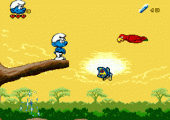
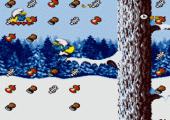
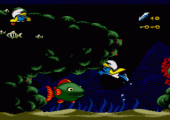
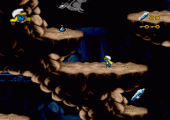
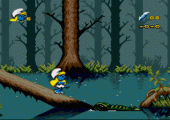
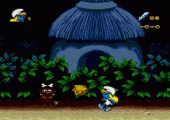
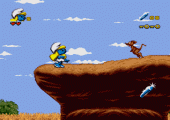
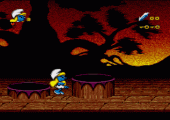
I suspect Smurfs 2 isn’t really compatible with 60Hz systems. Of course, it has region lockout, which one needs to bypass with a Game Genie (or a hex editor) in order to play the game at all. But every time I’ve played at 60Hz, whether on real hardware or an emulator, it’s crashed about 2/3 of the way through the third part of South America. At 50Hz on an emulator, I made it through with no problem.
As for the quality of the game, the jury’s out until I play further into it, but so far I think the (incredibly rare) SMS version is significantly better. Certainly the first area of the Mega Drive game is a terrible way to start, with too much emphasis on teleportation and confined forest spaces with obscured visibility. I enjoyed StarMist’s review, though.
Don’t pay attention to this review, Smurfs 2 is a great game